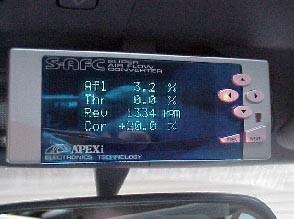The 5th generation Nissan Maxima (2000-2003) boasts a potent VQ30DE engine, but its factory tuning is often conservative, prioritizing fuel efficiency and knock suppression over outright performance. For enthusiasts seeking to unlock the true potential of their 5th gen Maxima, understanding the fundamentals of tuning is crucial. This guide delves into the why and how of tuning, focusing on optimizing air/fuel ratio (AFR) and ignition timing for noticeable horsepower gains.
Why Tune a 5th Gen Maxima?
Nissan engineers programmed the Maxima’s ECU with a conservative fuel and ignition map to accommodate variations in fuel quality and driving conditions. This approach, while reliable, leaves performance on the table. At wide-open throttle (WOT), the ECU operates in open-loop mode, relying on pre-set tables instead of real-time feedback from oxygen sensors. This results in a less-than-optimal AFR, hindering performance. Modifications like headers and exhaust systems further exacerbate this issue, necessitating tuning adjustments.
Understanding Air/Fuel Ratio (AFR)
AFR, the ratio of air to fuel in the combustion chamber, is a critical factor in engine performance and efficiency. A stoichiometric AFR of 14.7:1 represents a perfect balance, where all fuel is burned completely. However, for maximum power in a naturally aspirated VQ30DE, a slightly richer AFR of 12.7-13.5:1 is ideal. An untuned 5th gen Maxima with bolt-on modifications often runs excessively rich at WOT, negatively impacting power output. Tuning allows for precise AFR adjustments, maximizing performance and preventing potential damage from running too lean.
Tuning Options for the 5th Gen Maxima
Several options exist for tuning a 5th gen Maxima, each with its own advantages and limitations:
- Air/Fuel Controllers (AFC): Devices like the Apexi VAFC/VAFC2 and SAFC/SAFC2 manipulate the MAF sensor signal to adjust AFR. They are relatively easy to install and tune, making them a popular choice for basic AFR adjustments. However, they lack advanced features and indirectly affect ignition timing, which can be problematic without careful monitoring.
 alt text describing image content: An Apexi Super Air Flow Converter (SAFC) unit.
alt text describing image content: An Apexi Super Air Flow Converter (SAFC) unit. - Piggyback Engine Management Systems: Options like the GReddy e-Manage Ultimate offer more comprehensive tuning capabilities, including direct control over fuel and ignition timing for each cylinder. They allow for precise adjustments across the entire RPM range and provide data logging capabilities for monitoring key engine parameters.
Monitoring AFR with a Wideband O2 Sensor
Tuning without a wideband O2 sensor is like navigating blindfolded. A wideband sensor provides real-time AFR readings from the exhaust, allowing for accurate adjustments. Models with data logging capabilities, such as the Innovate LC-1, enable detailed analysis and fine-tuning.
Optimizing Ignition Timing
Ignition timing, the precise moment the spark plug ignites the air/fuel mixture, is crucial for maximizing power. Advancing timing can significantly increase horsepower, but excessive advance can lead to damaging engine knock. Dyno tuning is the ideal method for optimizing ignition timing, as it allows for precise adjustments across the entire RPM range while monitoring for knock. However, careful street tuning with a knock sensor and wideband O2 sensor can also yield noticeable gains.
Conclusion
Tuning a 5th Gen Nissan Maxima can unlock significant performance potential. By optimizing AFR and ignition timing, owners can experience noticeable improvements in horsepower and throttle response. Whether using an AFC for basic adjustments or a piggyback system for more comprehensive control, understanding the underlying principles and utilizing proper monitoring tools are essential for achieving optimal results. Remember, responsible tuning requires careful consideration and attention to detail. Always prioritize engine safety and reliability.
